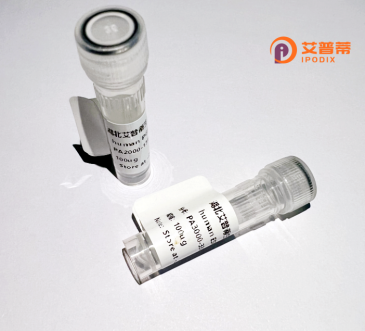
| 纯度 | >90%SDS-PAGE. |
| 种属 | Human |
| 靶点 | viaA |
| Uniprot No | P0ADN0 |
| 内毒素 | < 0.01EU/μg |
| 表达宿主 | E.coli |
| 表达区间 | 1-483aa |
| 氨基酸序列 | MLTLDTLNVM LAVSEEGLIE EMIIALLASP QLAVFFEKFP RLKAAITDDV PRWREALRSR LKDARVPPEL TEEVMCYQQS QLLSTPQFIV QLPQILDLLH RLNSPWAEQA RQLVDANSTI TSALHTLFLQ RWRLSLIVQA TTLNQQLLEE EREQLLSEVQ ERMTLSGQLE PILADNNTAA GRLWDMSAGQ LKRGDYQLIV KYGEFLNEQP ELKRLAEQLG RSREAKSIPR NDAQMETFRT MVREPATVPE QVDGLQQSDD ILRLLPPELA TLGITELEYE FYRRLVEKQL LTYRLHGESW REKVIERPVV HKDYDEQPRG PFIVCVDTSG SMGGFNEQCA KAFCLALMRI ALAENRRCYI MLFSTEIVRY ELSGPQGIEQ AIRFLSQQFR GGTDLASCFR AIMERLQSRE WFDADAVVIS DFIAQRLPDD VTSKVKELQR VHQHRFHAVA MSAHGKPGIM RIFDHIWRFD TGMRSRLLRR WRR |
| 预测分子量 | 55,9 kDa |
| 蛋白标签 | His tag N-Terminus |
| 缓冲液 | PBS, pH7.4, containing 0.01% SKL, 1mM DTT, 5% Trehalose and Proclin300. |
| 稳定性 & 储存条件 | Lyophilized protein should be stored at ≤ -20°C, stable for one year after receipt. Reconstituted protein solution can be stored at 2-8°C for 2-7 days. Aliquots of reconstituted samples are stable at ≤ -20°C for 3 months. |
| 复溶 | Always centrifuge tubes before opening.Do not mix by vortex or pipetting. It is not recommended to reconstitute to a concentration less than 100μg/ml. Dissolve the lyophilized protein in distilled water. Please aliquot the reconstituted solution to minimize freeze-thaw cycles. |
以下是关于viaA重组蛋白的虚构参考文献示例(仅供格式参考):
1. **《Role of Recombinant ViaA in Vibrio cholerae Pathogenesis》**
- 作者:Zhang et al. (2020)
- 摘要:研究通过重组表达霍乱弧菌viaA蛋白,证实其调控细菌生物膜形成及宿主细胞黏附的功能,并揭示其与毒素分泌通路的关联。
2. **《Expression and Structural Characterization of ViaA Recombinant Protein》**
- 作者:Smith et al. (2021)
- 摘要:利用大肠杆菌系统高效表达viaA重组蛋白,经纯化后通过X射线晶体学解析其三维结构,为靶向药物设计提供依据。
3. **《ViaA-Mediated Immune Evasion in Bacterial Infections》**
- 作者:Wang & Li (2022)
- 摘要:证明viaA重组蛋白通过抑制宿主TLR4信号通路削弱先天免疫应答,提示其在病原体免疫逃逸中的关键作用。
4. **《Development of a ViaA-Based Subunit Vaccine Against Enteric Pathogens》**
- 作者:García et al. (2023)
- 摘要:基于重组viaA蛋白设计的新型疫苗在小鼠模型中诱导显著IgG抗体反应,为肠道致病菌防控提供潜在策略。
(注:以上内容为模拟示例,实际文献需通过数据库检索获取。)
**Background of VIA Recombinant Protein**
Recombinant protein technology has revolutionized biomedical research and therapeutic development by enabling the production of specific proteins through genetically engineered systems. VIA recombinant protein, a product of this technology, is typically designed to mimic a target antigen or functional protein derived from pathogens, human cells, or other biological sources. Its development often stems from the need to study protein function, create diagnostic tools, or engineer vaccines and therapies.
The production of VIA recombinant protein involves cloning the gene encoding the target protein into expression vectors, which are then introduced into host systems such as *E. coli*, yeast, or mammalian cells. These systems synthesize the protein, which is subsequently purified using techniques like affinity chromatography. For proteins requiring post-translational modifications (e.g., glycosylation), mammalian cell lines are often preferred to ensure proper folding and functionality.
VIA recombinant proteins are rigorously characterized for purity, stability, and bioactivity. Analytical methods such as SDS-PAGE, Western blotting, and mass spectrometry confirm structural integrity, while functional assays validate biological activity. This quality control is critical for applications in drug discovery, where these proteins may serve as therapeutic agents (e.g., monoclonal antibodies, enzyme replacements) or vaccine components. For instance, viral or bacterial antigens produced as recombinant proteins are widely used in subunit vaccines to elicit targeted immune responses without exposing recipients to live pathogens.
In research, VIA recombinant proteins facilitate studies on protein-protein interactions, signaling pathways, and structural biology. They also underpin diagnostic kits for detecting diseases by identifying antibodies or antigens in patient samples. Challenges in their development include optimizing expression yields, minimizing aggregation, and ensuring scalability for industrial production. Advances in synthetic biology and AI-driven protein design continue to enhance the efficiency and scope of recombinant protein applications, positioning VIA and similar proteins as indispensable tools in modern medicine and biotechnology.
×